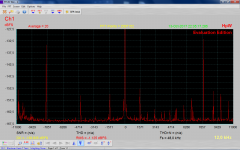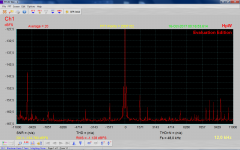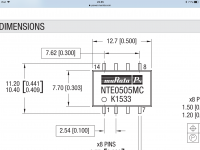Given that the talk turned to the quality of clocks in these dacs..
Here I would like to show a little test that I wished to do.
With this new arrival, the SITO V. 1.2 dac equiped with very good quality clocks, dedicated power supply, & galvanic isolation - I had been wondering if one would be able to detect any measurable changes due to this. I mean any change from the previous model Mirand V 1.1 dac to the SITO dac.
The old model, as we know, is based on Fox Xpresso crystals, have a mixed power supply scheme and is not isolated galvanically.
It looked to be not that easy because the usual jitter tests already for the Mirand dac looked quite clear.
So I tried to push the setup to the limits.
I drive the DUT dac modules into my usual EMU1616m card with AK5394A.
The dac is piloted in upsampled PCM mode, set to 384kHz -so as to stress as much as possible the jitter response.
The sound card is used instead in it's cleanest mode, 48kHz/ 24bit recording.
The first shot is the Mirand V 1.1 original version.
The second shot is the SITO V. 1.2 new version, tested on it's USB input, with USB power external.
Here I would like to show a little test that I wished to do.
With this new arrival, the SITO V. 1.2 dac equiped with very good quality clocks, dedicated power supply, & galvanic isolation - I had been wondering if one would be able to detect any measurable changes due to this. I mean any change from the previous model Mirand V 1.1 dac to the SITO dac.
The old model, as we know, is based on Fox Xpresso crystals, have a mixed power supply scheme and is not isolated galvanically.
It looked to be not that easy because the usual jitter tests already for the Mirand dac looked quite clear.
So I tried to push the setup to the limits.
I drive the DUT dac modules into my usual EMU1616m card with AK5394A.
The dac is piloted in upsampled PCM mode, set to 384kHz -so as to stress as much as possible the jitter response.
The sound card is used instead in it's cleanest mode, 48kHz/ 24bit recording.
The first shot is the Mirand V 1.1 original version.
The second shot is the SITO V. 1.2 new version, tested on it's USB input, with USB power external.
Attachments
Last edited:
The samplng rate is 48kHz multiples, so the test signal is FS/4 frequency, 12kHz tone.
Almost full scale.
In the first graph , the un-isolated Mirand dac shows an obvious modulation at the standard 8kHz high speed USB frames frequency; plus a series of spurs at 1kHz distance, 1msec USB packet signaling.
The 4,5-4,6kHz side lobes most probably are due to the Fox oscillators.
There is a non- zero contribution also from the soundcard itself -- those spurs at 1.5kHz and at the top freq.range. one can observe all these still present also in the SITO spectra.
On the other hand, the SITO V. 1. 2 spectra shows a much cleaner picture, almost all USB correlated signatures are gone, mainly the soundcard related residuals are left only. (And a spur tone at 2kHz, plus a little 50Hz contamination )
So, I would say that the choices made by Sonny - - are working..
Ciao, G
Almost full scale.
In the first graph , the un-isolated Mirand dac shows an obvious modulation at the standard 8kHz high speed USB frames frequency; plus a series of spurs at 1kHz distance, 1msec USB packet signaling.
The 4,5-4,6kHz side lobes most probably are due to the Fox oscillators.
There is a non- zero contribution also from the soundcard itself -- those spurs at 1.5kHz and at the top freq.range. one can observe all these still present also in the SITO spectra.
On the other hand, the SITO V. 1. 2 spectra shows a much cleaner picture, almost all USB correlated signatures are gone, mainly the soundcard related residuals are left only. (And a spur tone at 2kHz, plus a little 50Hz contamination )
So, I would say that the choices made by Sonny - - are working..
Ciao, G
Hi
To cut the internal 5v, just follow the red arrow and cut the leg at the NTE0505.
Then just set the external 5v at the pins in the red cirkel - red is plus 5v and black is minus.
cheers Anders
Thanks. That's scary... Cut it really.? So it's pin 1 right?
Sonny, would it be a benefit if i would use separate Salas shunt PSU for Crystek clock?
Until now, the DAC V1.1 sound is great and I really like it. It's great that I can use USB or I2S inputs.
Thank you.
Wow.. Super built. How did the salas bib work out for u vantalika?
I personally using the reflector d for digital only
Wow.. Super built. How did the salas bib work out for u vantalika?
I personally using the reflector d for digital only
In this configuration I heard the most natural sound in my system.
PSU Salas made a huge change for the better.
With Salas BiB I separately feed I / V and preamplifier.
With Salas ReflectorD - Mirand DAC.
In this configuration I heard the most natural sound in my system.
PSU Salas made a huge change for the better.
With Salas BiB I separately feed I / V and preamplifier.
With Salas ReflectorD - Mirand DAC.
Great to hear. Will try to build it. Have the bib board but was being lazy. Thanks for the review
Your built looks so delicious. Yumm
Last edited:
Pin 8
Hi
It’s actually pin 8 - see picture
Hi
It’s actually pin 8 - see picture
Thanks. That's scary... Cut it really.? So it's pin 1 right?
Attachments
Hi Sonny
Hope you are doing good.
My dac is sounding very well, better than some of r-2r dac's my friends own. However there is a small glitch when playing DSD using Allo USB Bridge as Roon end point.
When I play DSD 64/128 native I get no sound or sometimes buzzing sound from my speakers. When I cycle through the filters it picks up again and starts playing till I power off the dac. Any idea what could be the reason? I don't have any problems with PCM.
It's running the same firmware I got with the dac. The links to newer firmware you shared were not working. My marantz SA8005 CD player which also works as a USB DSD dac doesn't have this problem.
Any help would be appreciated.
Hope you are doing good.
My dac is sounding very well, better than some of r-2r dac's my friends own. However there is a small glitch when playing DSD using Allo USB Bridge as Roon end point.
When I play DSD 64/128 native I get no sound or sometimes buzzing sound from my speakers. When I cycle through the filters it picks up again and starts playing till I power off the dac. Any idea what could be the reason? I don't have any problems with PCM.
It's running the same firmware I got with the dac. The links to newer firmware you shared were not working. My marantz SA8005 CD player which also works as a USB DSD dac doesn't have this problem.
Any help would be appreciated.
Last edited:
Hi Sonnya, sorry to bother you but you still haven't sent me the small encoder pcb to complete your Dac. Please send me a private email. thanks
SB
SB
Hi
Usb ..do it use the 5v from the PC usb ...or does it get supply from the dac board
it is the older dac board with only usb connection
Best Bjarne
Usb ..do it use the 5v from the PC usb ...or does it get supply from the dac board
it is the older dac board with only usb connection
Best Bjarne
thanks Joseph
so it will be ok to only use 3 wire usb from my PC
Have someone try to change the clocks on the 1.0 dac board..CCHD-575-25-24.576
so it will be ok to only use 3 wire usb from my PC
Have someone try to change the clocks on the 1.0 dac board..CCHD-575-25-24.576
It needs the 5v
The Dac needs the 5v, but it is only used as a handshake, so the dac know there is an input.
Cheers
Aboe
thanks Joseph
so it will be ok to only use 3 wire usb from my PC
Have someone try to change the clocks on the 1.0 dac board..CCHD-575-25-24.576
The Dac needs the 5v, but it is only used as a handshake, so the dac know there is an input.
Cheers
Aboe
Aboe
i see ,then i will use normal 5 wire usb cable..
will have Dac and Pre wired op to play later next week
i see ,then i will use normal 5 wire usb cable..
will have Dac and Pre wired op to play later next week
Yes I did change the clocks to NDK 2520 SDA.
Be careful, the CCHD-575-25-24.576 do not fit!
They don't have Enable Pin, and the board uses it!
Ciao, George
Be careful, the CCHD-575-25-24.576 do not fit!
They don't have Enable Pin, and the board uses it!
Ciao, George
- Home
- Vendor's Bazaar
- AK4490 USB Dac with dsd support.


